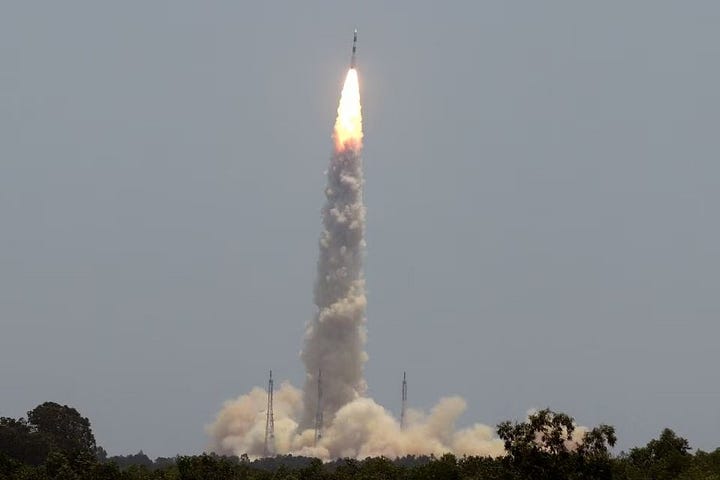
India’s Rapid Follow-up to Moon Landing: Rocket Launch for Solar Study
Fresh off the heels of India’s lunar success, the nation’s space agency embarked on a new mission last Saturday, aiming to study the sun in its maiden solar endeavor.
Broadcasted live on the Indian Space Research Organisation’s (ISRO) website, the rocket left a spectacular trail of smoke and fire while jubilant scientists applauded. The broadcast garnered an impressive audience of over 860,000 viewers, with thousands congregating at a viewing gallery near the launch site to witness the probe’s liftoff. The primary objective of this mission is to investigate solar winds, which are known to cause disturbances on Earth, commonly manifested as auroras.
Named “Aditya-L1” after the Hindi word for the sun, this spacecraft commenced its journey just a week after India achieved a historic feat by becoming the first country to land on the moon’s south pole, surpassing Russia’s lunar endeavors. India’s Chandrayaan-3 outperformed Russia’s Luna-25, despite Russia’s more potent rocket. Prime Minister Narendra Modi has been advocating for India’s space missions to assume a more prominent role on the global stage, particularly in the face of competition from the United States and China. Home Affairs Minister Amit Shah, on the social media platform X, lauded the launch as a “giant step” toward realizing Modi’s vision.
The Aditya-L1 spacecraft is designed to travel approximately 1.5 million kilometers (930,000 miles) over a span of four months, which is significantly shorter than the sun’s distance from Earth, approximately 150 million kilometers. It will ultimately halt its journey at a unique space location known as a Lagrange Point, where gravitational forces maintain stability, reducing the spacecraft’s fuel consumption. Sankar Subramanian, the principal scientist of the mission, explained that this mission would provide valuable data not available from any other mission, shedding light on the sun’s dynamics and the inner heliosphere, which holds vital significance for contemporary technology and space weather understanding.
Furthermore, this mission has the potential to make significant contributions to scientific knowledge. According to Somak Raychaudhury, involved in developing certain components of the observatory, energy particles emitted by the sun can impact satellites responsible for communication on Earth. He noted that major communication disruptions have occurred when satellites were struck by significant corona emissions. In today’s space environment, where global private entities heavily focus on satellites in low Earth orbit, the Aditya-L1 mission holds substantial importance.
Scientists also aspire to gain insights into the effects of solar radiation on the multitude of satellites orbiting Earth, especially as satellite numbers continue to rise with projects like Elon Musk’s SpaceX Starlink communications network. Rama Rao Nidamanuri, head of the Department of Earth and Space Sciences at the Indian Institute of Space Science and Technology, emphasized the importance of safeguarding satellites in low Earth orbit due to increasing pollution from private participation.
In the long term, data from this mission could enhance our understanding of the sun’s influence on Earth’s climate patterns and the origins of solar wind, the stream of particles emanating from the sun throughout the solar system, as articulated by ISRO scientists.
Under the leadership of Modi, India has privatized space launches and is actively seeking foreign investment to achieve a five-fold increase in its share of the global launch market within the next decade. As space increasingly becomes a global business, India is positioning ISRO’s successes as a testament to its capabilities in the sector.
Reporting by Nivedita Bhattacharjee in Bengaluru; Additional reporting by Jayshree P Upadhyay; Editing by William Mallard and Miral Fahmy